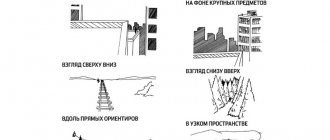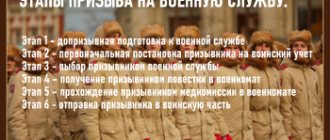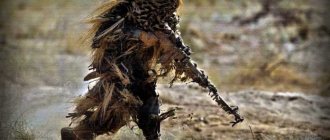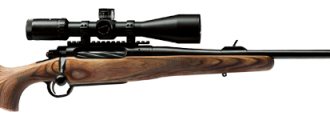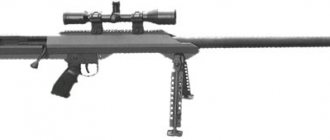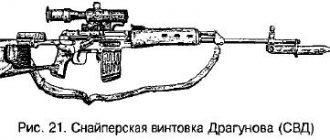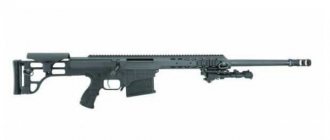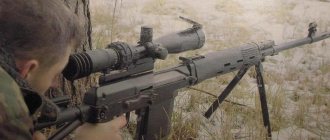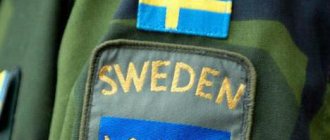How necessary is it to camouflage weapons with tape in hunting conditions? Disguise in army units
a firearm is not needed, but it is mandatory in special forces that are located in a hot spot and actively participate in hostilities. In airsoft, good weapon camouflage can lead your team to victory. The same is true for hunting: in some cases, you can neglect the camouflage of a weapon and not miss anything, but in other conditions, a flashing barrel can scare away all the game and ruin the hunt completely.
Definitely, camouflage should not contradict the rules for transporting hunting weapons or violate them in any way. Make sure you remember these rules by brushing up on this article.
Some manufacturers of hunting weapons produce their models already camouflaged in the color of reeds or dry grass. Such semi-automatic devices come in very handy for lovers of goose and duck hunting. How to determine in which cases it is necessary to camouflage small arms and how to do it as efficiently and inexpensively as possible?
Sniper disguise. Training snipers in camouflage techniques
Details Category: Sniper Date of publication 09.26.2013 20:53 Author: Super User For a sniper, camouflage is no less important than the ability to shoot accurately, therefore, in the sniper training system, camouflage must be present in every lesson, both in the field and in the city conditions. A sniper's disguise is a personal cover he uses in combat in order to avoid being noticed by the enemy. Along with knowing how to adjust his clothing for better camouflage, a sniper must also know how to make the most of the terrain, proper shooting positions, and ways of moving to remain undetected.
A complete scam, or the most expensive “balloons”
From the outside, this may seem funny or even frivolous - inflatable models simulating military equipment... But let's take it in order: the beginning of the “swindle” was laid during the Second World War, when a full-size inflatable model of the Sherman tank was first used, which only very at a short distance it could be distinguished from a real combat vehicle.
During the war years, the production of fake tanks was established in the USSR, and on an industrial scale. The tanks were not only inflatable, but also made of plywood, which was cheaper. And special teams of artists and designers painted the fakes, giving the fake equipment an extremely realistic look. For example, in the Battle of Kursk, along with real military equipment, 500 fake tanks and 200 aircraft took part, which quite successfully played the role of distracting extras.
© airandspace.si.edu
Airplanes were made not only inflatable, but also made of plywood.
And since a plywood “army” of tanks and airplanes was relatively inexpensive, they could be created in almost any quantity. At the same time, a hundred or two such “pieces of wood” installed on the battlefield could well confuse the enemy’s plans.
It should be noted that during the Great Patriotic War, larger-scale “performances” were staged—fake airfields and fortifications were created en masse, which worked flawlessly and forced the enemy to waste ammunition. This trick even formed the basis of the famous post-war comedy film “A Troubled Household.”
In our time, the illusion of deception has gone even further. For example, when creating modern models of military equipment, a fabric is used that is capable of reflecting radio waves, due to which the model on locator screens is identified as a real target, and the “inflatable troops” are equipped with heating, which makes it possible to deceive thermal imagers.
Moreover, the inflatable equipment is so weightless that even one person can handle it. The approximate weight of one inflatable tank is 10 kg, and its assembly time does not exceed 10 minutes. Today in the arsenals of the Russian army there are inflatable S-300, T-72 and T-80 tanks, as well as Su-27 and MiG-31 fighters.
This is interesting: Non-standard NSP prevention service
Unmasking signs
Unmasking signs are anything that can reveal the sniper's location to the enemy. The sniper himself must know these signs in order to detect the enemy and not allow himself to be detected. These signs are grouped according to three main parameters:
1. Sound. It can be produced by movement, conversation, noise from equipment (its clattering, strumming, etc. If the enemy can mistake an insignificant background sound for natural, then the conversation immediately reveals the presence of an outsider.
In this regard, before going on a mission, it is necessary to ensure maximum noiselessness of the equipment; ideally, it should not make the slightest sound when running or walking.
The sniper must move with soft, slow steps and make careful movements, being aware of where he places his feet and how he overcomes various obstacles, such as how he moves brush to pass through it.
2. Movement. Movement attracts human attention even in everyday, peaceful life.
Detecting a stationary, well-camouflaged target is very difficult, almost impossible. A slowly and carefully moving target may go unnoticed, but a fast and sudden movement will be noticed immediately.
The sniper must be able to move unnoticed while under the surveillance of optical equipment: again we come to the point that careful, slow movements are needed.
3. Incorrect disguise. A huge number of targets are detected and destroyed due to their improper camouflage. These factors are divided into three groups:
- Shine. This is the most common unmasking factor. Shine comes from open and untinted reflective objects, such as lenses on optical instruments. This can be prevented by shading the optics with a piece of paper or by finding a shadow. Any reflective light from the subject must be masked.
- Outlines. The outlines of objects and body parts: sniper weapons, the head and body of a sniper or another must be hidden. Such outlines are visible from a very long distance and are the second most important unmasking factor. Therefore, they need to be given features that are visually indistinguishable from the general background of the area.
- Contrast with the general background. When using a cover position, it is necessary to choose such a general background that it completely, or at least as much as possible, absorbs the external outlines of the sniper and his equipment. Contrast means standing out from the general background, as, for example, a man standing in a black uniform on the top of a hill covered with green grass stands out against the sky. Usually there is a noticeable color or shape that differs from the general background. Therefore, the sniper should use the background color and stay in the shadows as much as possible.
Advantages of camouflage tape
Advantages of camouflage tape for small arms:
- Simplicity and speed of application.
In a couple of minutes, you can wrap your weapon in a spiral and achieve high-quality camouflage, since the tape has camouflage applied to suit any environmental conditions of the hunter’s choice.
- Protection of weapons from scratches and chips.
An important aspect for owners of valuable, antique or simply expensive weapons. This is especially true if the handle of your gun is made of expensive wood and decorated with fine carvings.
- Tactile sensations.
A wrapped weapon is more pleasant to hold in your hands: the tape is soft, does not rub or burn with cold, as happens with metal parts of guns in a chilly wind or damp weather.
- Variability.
You can buy ribbons in different colors and change them depending on the outdoor conditions of your hunting area.
- Low cost.
The prices for camouflage tape are low, and with the same tape you can go hunting several times. Even after getting wet, the tape can be dried and used again. Winding up and re-wrapping a weapon with camouflage tape is a quick and easy process, so using the tape will not present any difficulty or discomfort to you.
Masking exposed areas of the sniper's body
Absolutely all exposed areas of skin must be covered or camouflaged: face, ears, back of the neck, hands. Those parts of the face that are usually shaded need to be brightened. Protruding parts that can cause shine - such as the nose, forehead, cheeks, chin - must be darkened with a special camouflage waterproof paint, the color matching the type of terrain.
The principle of this coloring is to “break” the vertical and horizontal lines of the eyes, nose and mouth. Apply diagonally, starting from the forehead and temples. The forehead, cheekbones, nose and chin are painted dark, everything else is light.
The design and its color must be chosen so that it blends with the surrounding vegetation and shadow. For a summer forest, it is good to use light and dark green colors. White and gray colors should be used in snowy areas, while sand and light brown should be used in the desert.
The types of facial patterns can range from asymmetrical stripes across the entire face to large spots. As practice has shown, it is best to use a combination of stripes and spots. What definitely shouldn’t happen is wild colors and bright colors that will stand out against the general background as unnatural spots.
Use of aerosols and fumes
Hand-held smoke grenades are designed to set up camouflage smoke screens in close combat by single soldiers and small units, as well as to camouflage exits, crews and various military equipment. Black smoke grenades can also be used to simulate the burning of tanks, infantry fighting vehicles and self-propelled artillery units.
There are four types of hand smoke grenades; RDG-P and RDG-2x with a metal-chloride mixture of white smoke, RDG-2ch with an anthracene mixture of black smoke. RDG-26 - white smoke.
Characteristics of hand smoke grenades
| Parameter | RDG-P | RDG-2x | RDG-2b | RDG-2ch |
| Weight, kg | 0,5 | 0.5-0,6 | 0,5-0,6 | 0.5-0.6 |
| Burn-up time, s | 3.5 | 15 | 15 | 15 |
| Duration of intense smoke formation, min | 1-2 | 1-1.5 | 1-1.5 | 1-1.5 |
| Length of invisible smoke screen, m | 35 | 25-35 | 20-25 | 10-15 |
Camouflage camouflage
Camouflage camouflage of the “Gilli” type or “Leshy suit” is a camouflage uniform or outer cape covered with pieces of an indeterminate shape of camouflage color.
The suit trim strips are folded in half and sewn mainly on the legs, arms, shoulders and back. They are then frayed or cut lengthwise to give the costume a “vegetal” look. The suit may also include fine mesh sewn at the back of the shoulder neckline, which is draped over the head like a blanket. It is used to camouflage the outline of the head, the optical sight, to provide the ability to move the arms without fear of being detected, and also to conceal the ejection of cartridges.
When the cover is draped over the head, it should be lowered to the level of the belt, to which camouflage trim should be attached to hide the outline of the head and large pieces of netting. When walking, the sniper throws the blanket behind his head so that nothing impairs his vision or interferes with his movements.
A group of snipers in camouflage
You should always remember that a camouflage suit does not make a person invisible. The sniper must always take advantage of natural camouflage and cover. Small loops are sewn onto the suit to insert freshly picked natural vegetation into them: branches, grass and other plants, preferably those that do not wither for a long time.
By wearing a camouflage suit, the sniper will stand out from ordinary military units, making him a prime target for enemy soldiers. Therefore, this suit should only be worn when the sniper is performing a special combat mission separate from his main unit.
If you do not have the necessary components to create a full-fledged camouflage suit, then using the appropriate techniques and materials you can make a temporary suit.
In particular, the finishing can be replaced with scraps cut from socks, linen bags or any other material at hand. The material is then attached to the suit in the same way, it is important to hide the texture and outline of the uniform.
The color of fabric or other material can be varied using dirt, coal, paint, or coffee grounds. Oil or grease should not be used because of their strong odor, and real foliage attached to the artificial camouflage helps to blend the costume into the general background. It must be replaced as it ages or when the terrain changes.
SECTION 6. CASKING THE SNIPER POSITION ON THE GROUND
SECTION 6. CASKING THE SNIPER POSITION ON THE GROUND
A sniper is a hunter, and the hunter must be invisible. Any sniper who tries to work undisguised almost immediately becomes a target for the enemy. Positions for the sniper’s work have to be chosen and equipped literally under the enemy’s nose, sometimes in inconvenient, open and seemingly unsuitable places. Therefore, the camouflage of the position must be impeccable, look natural and not stand out from the surrounding landscape. Winter and summer camouflage are different. It is easier to camouflage in winter because the main colors in winter are black and white. There is, of course, more white, which is why the sniper wears all white. The camouflage coat with a white hood should be white, matching the color of the snow. The rifle should also be wrapped in something white. An ordinary medical bandage is best suited for these purposes. The optical sight and belt are also wrapped with a bandage. The flesh color of the face and hands gave away more than one sniper, so a white cloth or paper mask with narrow slits for the eyes is put on the face (photo 153). These narrow slits play a sun protection role when working during the day under the bright sun among white snow. Such powerful illumination literally blinds the eyes. It is impossible to shoot accurately in such conditions.
Photo 153. Winter equipment for a sniper
To work in winter, the sniper naturally warms himself and puts on a camouflage coat over a warm jacket. One way or another, the left hand should be in a warm, thick mitten - both for insulation and in order to neutralize the pulsation of the hand. The right hand should also be in a mitten, precisely in a mitten, and not in a glove, so that the fingers are better warmed. A slot is made in the right glove for the shooting index finger. If it is necessary to fire a shot, the shooting finger is exposed from the mitten and rests on the trigger. Of course, both mittens should be white or covered with white covers.
Gloves on your hands and a mask on your face are required - they protect against frostbite. In addition, the mask holds back steam from breathing. This steam gave out and killed more than one shooter. The long lower edge of the fabric mask is tucked under a wide collar, and the steam from breathing through this “trunk” is directed “under the skin” and additionally warms the sniper. The sniper's jacket, camouflage coat and trousers should not be tight - they should be a number or two wider than normal clothing and provide freedom of movement for the sniper while lying down. In loose clothing, involuntary body movements, inevitable in the cold, are not so noticeable from the outside, and besides, in loose clothing it is warmer. Winter sniper positions can be open or closed. Open positions, that is, not protected by anything and not covered from above, are occupied by the sniper for the time that he can withstand in the cold. Usually these are reserve positions and jumping positions for waiting for the target to appear, instantly hitting it and quickly disappearing from this position, without waiting for it to be covered with mortar fire. Open positions are temporary, but this does not mean that they do not need to be prepared and a place chosen for them. Look at photo 154. The sniper very wisely chose and prepared an open temporary position to hit targets at an object located on the side of the hypothetical enemy at a distance of 350 meters. The sniper position is located on the outskirts of the forest. Ahead of the position is a sparse bush. This rare bush does not interfere with the sniper (and the photographer who took the picture) from seeing the object and what is happening on it, because the bush is located close to the position. But as soon as you move away at least a hundred meters and look at the position from the enemy’s side, everything that is behind these rare bushes from the side of the position ceases to be distinguishable. Among other things, the smoke from the shot dissipates behind the wall of bushes and is therefore not visible from the outside. This is the so-called “tulle curtain effect” - everything is visible from the room because of the curtain, but nothing is visible from the street behind the curtain. But even in this case, the sniper tries to bury himself deeper in the snow and not expose himself again. In this case, the snow was shallow, and the sniper could not dig into it, so he raked the parapet in front and from the sides (photo 155). In front, the sniper thoroughly sprinkled water on the parapet and the space 2-3 meters in front of it so that an ice crust would form and dry snow would not rise when gunpowder gases were fired (photo 156). The snow whirlwind, thrown up after the shot, rises quite high and very clearly shows the enemy the place from where the shot was fired.
Photo 154. Sniper in an open position
Photo 155. Sniper buried in the snow
Photo 156 Open sniper position from the front. The dotted line indicates the space sprinkled with water to form an ice crust.
If the sniper has the opportunity, he not only sprinkles, but also pours water on the parapet in front of him and on the sides of him. After this, the position will freeze and protect the owner from bullets and shrapnel. This was done by the Germans, who did not like to change positions and fired from them for a long time. Ours could not reach them due to the lack of maneuverable small-caliber mortars. Russian snipers preferred to freeze to the extreme, burying themselves as deep as possible in the snow, and after one or two shots they “dropped” from the position, without waiting for the Germans to cover it with mortar fire. The Germans had small tray-type mortars in every platoon. Different opportunities - different tactics. But in any case, our, German, and Finnish snipers equipped closed, insulated main positions, where they had to stay for a long time - both to track down the enemy and for observation. How can I do that? An old Finn who lives near Leningrad (now St. Petersburg) and who once served 10 years under Stalin for participating in World War II “on the wrong side,” showed the author a simple and accessible way for everyone to equip a closed sniper position using improvised means, always available in the middle climate zone. The old man used a short saw to cut a pine tree (not a Christmas tree - pine needles last a very long time, but spruce needles fall off immediately). Then he cut off a star knot from the butt part, from which branches grew in different directions. The old man turned the cut piece of pine over from top to bottom and placed it in the snow in this form. The result is a finished ceiling, like the frame of an umbrella (photo 157). There was little snow, and the old man put this frame on an old trench left over from the last war. Branches were cut from the same pine tree, and with this “spruce branches” the grandfather skillfully laid and intertwined the thick branches of the frame (photo 158). Then he started covering it all with snow. The trench began to disappear before our eyes (photo 159) and soon became even with the landscape. For viewing and shooting, an embrasure was made into which the rifle was exposed (photo 160) (for clarity of photography, the barrel was not masked with a bandage).
Photo 157. Frame - ceiling made from a fragment of a small pine
Photo 159. The position is covered with snow
Photo 158. The frame above the trench is intertwined and covered with pine paws
Photo 160. Completely camouflaged position. Embrasure for viewing and shooting from a rifle
Quite quickly a very cozy den was formed in which one could sit. After the entrance hole was covered with an old German bag from the household of this knowledgeable instructor, the inside of the position suddenly became unusually warm compared to -20°C, which was outside. Besides, there was no wind there. After the old man lit the end of the candle and placed it in the corner so that the fire was not visible from the embrasure from the outside, he could take off his mittens and hat and unbutton. The instructor explained all this by saying that the air cushion formed by the thick coniferous floor holds heat very well. In addition, as he said, “the light of a candle makes a person’s soul warmer,” and this makes the whole body warmer. According to him, with a couple of candles, one could hold out in such a position for a day in the most terrible frosts. To top it all off, the grandfather thoroughly watered the shelter from the outside, turning it into an ice pillbox. Judging by how quickly and dexterously he did all this in the gathering twilight, the author realized that this taciturn man received his 10 years in the camps for a reason. Quite often, snipers have to crawl up to the enemy and work on a previously scouted target from a jump, without a previously prepared position, and immediately disappear according to the “bite and hide” principle. To do this, you have to “emerge” for a short time. To appear unnoticed, you must not stand out against the background of the area, and for this the sniper must constantly turn his head and control the background that is behind him. In photo 161, the sniper did not do this and, in a white camouflage suit, appeared against a black background, moreover, on the smooth ridge of a high place. He has become noticeable, and in the 3-4 seconds he needs to shoot, he can be “taken off” himself.
Photo 161. Incorrect position: a sniper in a white camouflage suit stands out sharply against the black background of the crest of a high-rise building
In another case, the sniper correctly used the white background of the hill behind him (photo 162). In addition, it is not located on a flat line, but among the folds of the terrain and is therefore less noticeable. On the ground, a sniper always tries to take a position where there is cover for him, and so as not to stand out in it (or close to it) by the color of his camouflage. The shelter must be used correctly. In photo 163, the shelter (construction debris) is located to the right of the sniper. However, he is practically not protected by it. In this case, part of the head and shoulder is behind the cover, and the rest is open to oncoming damage.
Photo 162. Properly used white background behind the back. The sniper in white is almost invisible
Photo 163. Incorrectly used shelter. The sniper is to his left, and therefore the cover does not protect him
In photo 164, the sniper placed the rifle on top of the cover. In this case, the head and shoulders are open and not protected. In addition, this sniper, even in a camouflage suit, stands out above the cover from above. In photo 165 the cover is to the left of the sniper. In this case, the distance to the sniper is 5 meters, but he is practically invisible. If you look closely, you can see the round spot of the optical sight and the blackness of the rifle parts. Most of the head and the entire body are protected from oncoming enemy fire. To shoot, the sniper exposed part of his head, right shoulder and right arm.
Photo 164. Incorrectly used shelter. A sniper is on top of him, he is visible and unprotected
Photo 165. Correct position of the sniper behind cover. Cover to the left of the sniper, it protects him as much as possible, and the sniper is almost invisible
A natural question arises: when is it necessary to occupy and equip a position? The answer is categorical - only at night, when the enemy does not see it. And you have to crawl into position. When setting up a position, you cannot stand not only at full height, but even on all fours. Nowadays, at night everything is viewed by night vision devices and listened to by observers and reconnaissance officers. And not only bugged. The aforementioned Finn saw a man about a hundred meters away in the dark in winter. Therefore, everything must be done working at the “lower level”, and absolutely silently. In the summer, when nature turns green, the sniper tries to choose a position in the depths of the greenery and observe the situation through the gaps between the foliage. It is better if it is located 2-3 meters behind the line of small bushes that create the “curtain effect” described above. The sniper will be able to see everything that is happening outside, but he himself will be invisible. The flame of his shot will also not be noticeable, and the smoke from the shot will dissipate in the bushes. Nothing will come out. You cannot shoot too close to the leading edge of the bushes, because the exhaust of the shot will inevitably shake the branches, and this will give away the sniper's position. If a sniper has to shoot from an open place, his position may be unmasked by the swaying of tall grass from the exhaust. If there is no grass in this place, the position will be unmasked by a whirlwind of dust thrown up by powder gases. In dry weather, this vortex rises to a height of 2-3 meters and is visible from afar even with the naked eye. If it is enough for you to shoot from a certain position once and then instantly disappear from it, then in principle it does not matter. But if it becomes necessary to hold a position for at least two shots, grass is first thrown onto the dusty area, on top of which a camouflage net is laid. To prevent it from being blown away by the wind, it is pressed down with stones and secured by sticking branches into the ground with slingshots downwards or with wire U-shaped brackets. Of course, this is all done at night. It happens that snipers dig a trench, in front of which they stick a thick pine tree or even two into the ground. But this is done even before the enemy takes up positions and begins observation. The appearance of a pine tree that was not there before will be immediately noticed. Why do they prefer pine over any other tree even in summer? Because pine needles do not wither for a long time, do not fall off, and the pine tree does not need to be watered. Any other planting will “lower its ears” after half a day in the heat, and this will not go unnoticed. DO NOT FORGET! The best camouflage and the most skillful disguise are only good until the first shot, until the “snake bite”, and after the end of the moment of surprise they lose their meaning. The sniper must either leave the position, or his partner must get involved somewhere on the side and divert the enemy’s attention to himself.
Of course, the best place for a sniper position is in the shade. But sometimes the sniper chooses a brightly lit area, so bright that nothing can be seen in it. Especially if the sun shines into the enemy’s eyes. In summer it is harder to camouflage. The vegetation on the landscape is varied, so the military wears spotted camouflage so as not to stand out among the environment. What colors and patterns of camouflage clothing have not been invented over the past hundred years! But it was not possible to create a camouflage with a universal pattern. And not because vegetation in different places and climatic zones has a different shade. But because in nature there are no straight lines and the silhouette of a person in camouflage is somehow distinguished by linear outlines.
To “blur” the silhouette and make it as close as possible to the relief, camouflage is made “shaggy”. On clothes - a cape or overalls - they sew strips and scraps of fabric, pine needles, straw, etc., which are characteristic of the tone of a given area. “Shaggy” camouflages have been made since time immemorial. Nowadays such camouflage is called “herringbone”, “kikimora”, etc. In the 20th century, scraps of camouflage nets and old uniforms were used to make “shaggy” camouflages, which were sewn onto raincoats, jackets, tarpaulins... Everyone is more or less experienced a sniper sews his own camouflage as he sees fit. The camouflages produced by industry are the same and therefore sooner or later become visible to the enemy. Typically, snipers for working outdoors make “shaggy” camouflage in the form of a cape, so that involuntary movements under it are less noticeable. Depending on the circumstances of combat work, camouflage can be sewn with sleeves. Its silhouette should be “blurred”, reduced and asymmetrical.
To do this, all protruding parts must be “in the area of dark spots.” The criterion for evaluating a successfully made camouflage is its organic fusion with the environment, if its owner is wearing it in close proximity to something “shaggy” - bushes, thicket, tall growth, etc. The camouflage must be prepared with a hood. Loops and pockets are sewn onto the camouflage to attach branches, twigs, grass and anything else that is found in the area. Just like in winter, the sniper is unmasked by the flesh color of his face and hands. Therefore, a “shaggy” mask is put on the face, which also protects against mosquitoes, and “shaggy” mittens are put on the hands, and the right mitten has a slot for the “shooting” finger.
A sniper in shaggy camouflage is shown in photos 166-169. Shiny flywheels and sight contours unmask. Therefore, snipers put “shaggy” covers on their scopes (or wrap their scopes with “shaggy” scraps of uniform) (photo 170). The sniper wraps a “shaggy” tape or pulls a “shaggy” cover onto the rifle barrel. All these “tires” are attached very tightly, tied with laces, so that when shooting nothing moves or “breathes” on the rifle (see photo 153). A sniper in camouflage should look so inconspicuous that you wouldn’t want to look at him. This is the basic principle of camouflage. It should be dusty, worn out, hemmed with rags on different sides - in short, it should not look like anything. Therefore, a sniper working not in free sniper hunting mode, but in a mobile group, must have a minimum of camouflage - a slightly camouflaged rifle and a light “shaggy” jacket with sleeves - in case of a sniper ambush. The sniper, machine gunner and grenade launcher of the mobile group should stand out less, because the enemy will “put them down” first. Therefore, if you are going to camouflage, then camouflage everyone, so that no one stands out as a separate camouflage.
Photo 166
Photo 167
Photo 168
Photo 169
Photo 170. Camouflage of weapons and optical sights
The principle of working in open positions and using shelters is the same as in winter. It is advisable to prepare an open temporary position in advance, deepen it at least a little (in the event of artillery or mortar shelling, the only salvation is Mother Earth), camouflage it with turf and water it so that the grass does not wilt. Even in the best camouflage, you cannot take a position on the crest of a height, against the sky (photo 171). It is better to go down the slope and take a position where the vegetation is denser (photo 172), having the slope behind you and not standing out against its background. You should also not be on top of the shelter (photo 173). Even in the most successful camouflage, a sniper will stand out in relief from above. Place the sniper to the right and below the cover (shown by the arrow in photo 173), then he will truly blend in and not be noticeable.
Photo 171. The sniper’s position is between the shooters. On the crest of a height and against the sky it stands out quite clearly and is noticeable even in “shaggy” camouflage
Photo 172. In the previous photo, the sniper was in the position indicated by arrows 1. Now he is in the depths of the vegetation down the slope. His position is indicated by arrow 2 For clarity, he moved out from behind a bush, otherwise in his shaggy camouflage he would have been completely invisible
Photo 173. Incorrect use of cover topography Even in good camouflage, a sniper will stand out from above this cover. His place is to the right and below the cover (shown by the arrow)
Just like in winter, at other times of the year the sniper has to set up covered positions. It’s not even that in the fall, as the Russian sniper Vasily Zaitsev said, “everything that is wet and cold is all on you.” The fact is that in an open position you have to lie motionless. The slightest movement in the best camouflage can cost a sniper his life. Lying absolutely still is not as easy as it seems. In the summer, mosquitoes and flies pester you, and you can’t move to drive them away. You want to stretch and warm up - immobility is unnatural for a living person. Immobility makes the finger on the trigger go numb. I want to take a sip from the flask and chew something. And what’s worse, at the most inopportune time, he pulls out of need. Imagine what it looks like close to the object being tracked, at hearing distances of human speech.
Therefore, sniper-hunters, who at night crawled up to the enemy at a distance of 200 meters, and sometimes closer, successfully “squeezed” into some previously noticed fold of the terrain at the point from which the bend of the trench opened from the flank, and during daylight hours they waited for the appearance of this bend of an important target, they could easily crawl to theirs at night with their pants full.
Therefore, the main sniper positions in trench warfare are equipped in a closed type. At night, the sniper dug a trench in a no-man's land closer to the enemy, the soil from which he carried to the canvas further away and camouflaged. The trench was covered on top with a wire frame. Typically, snipers make a simple “spider” type frame; it consists of several pieces of soft wire with ends bent into loops, which are connected with a screw and nut (photo 174). The other ends are bent down so that they can be stuck into the ground and thus fix the structure. This frame folds (photo 175) and is therefore convenient for carrying. When opened, the frame is installed above the trench (photo 176). “Shaggy” camouflage is thrown over the frame, which is sprinkled on top with what is on the ground - leaves, dry grass, pine needles, straw, etc. After which the sniper’s position practically merges with the surrounding landscape and does not stand out from it (photo 177- 179). Such positions are disguised as hummocks, potholes, heaps of leaves, garbage, and when the position is located on a slope facing the enemy, generally as a level place. They always try to choose a position out of the blue, away from noticeable landmarks that attract attention, the distance to which has probably been calculated by the enemy.
Photo 174. The hinges of the folding frame are connected with a screw and nut
Photo 775. Frame in folded state
Photo 176. Opened frame installed above the trench
Photo 177. Frame covered with dry grass
Photo 178 Frame covered with a “shaggy” cape
Photo 179 A completely camouflaged position blends into the landscape
To create a convenient and reliable position during the Second World War, both the Russians and the Germans often used (sometimes still use) the so-called “camouflage stump” (photo 180, 181). This stump is made from scrap materials. Usually they take an old car tire as a basis, which is found in abundance on the roads, cut off the sides and sew birch bark or other tree bark around it. It happened that on both sides of such a “stump” the bark of different tree species was attached to make it convenient and quick to camouflage in different conditions and in different places. The camouflage stump is again placed on the trench, the ground next to which is sprinkled with leaves, grass, etc., depending on the conditions of the area. Sometimes craftsmen bolted fragments of springs from broken equipment or other thick metal plates between the rubber base and the bark. The stump turned into a pillbox, protecting the owner from bullets and shrapnel. Interestingly, the bullets penetrated the fixed steel plate and did not penetrate small steel plates of the same thickness, shock-absorbing rubber-based ones. It happened that the enemy, just in case, took aim at the stumps in his zone of control, after which he calmed down and no longer paid attention to the stump checked in this way.
Photo 180. Camouflage stump
Photo 181. Camouflage tree stump. The lid is open, the sniper's position is under the stump
In the city, camouflage should also be “shaggy”, only of a different color. As already mentioned, camouflage should be such that you don’t want to look in its direction - this is the basic psychological principle of camouflage. Who in the city don't you want to look at? Of course, on dirty and ragged homeless people. Therefore, urban camouflage is made in gray color (dry asphalt - this color predominates in the city) and covered with any gray-black patches and stripes. In addition, on the outside, the camouflage is moderately smeared with lime, soot, brick dust, in short, it is done so that the eye does not want to dwell on it. Places for sniper ambushes in the city are chosen so that you don’t want to look at them either. Usually these are heaps of garbage, landfills, and construction debris, which are found everywhere these days (photo 182).
Photo 182 A sniper among the construction debris, he is in the foreground, but in “shaggy” camouflage he is practically invisible
Urban camouflage is made in the form of a long-length jacket with wide sleeves - in the city a sniper often has to engage in hand-to-hand combat. In addition, for the purposes of operational expediency, such camouflage, inverted, is a jacket of a regular cut, wearing which you can move around the city without arousing unhealthy interest in yourself. This is very valuable for snipers of anti-terrorist units, who, in search of advantageous positions, are forced to independently move from object to object, sometimes passing by crowds of people. When sniping in the city, the gray-black-brown “shaggy” camouflage with the same mask on the face is practically invisible in the usual positions for a sniper - on construction sites and in ruins, in basements and attics, and in other dimly lit places.
But this is not enough for the city. Gunshot contacts that arise during special counter-terrorism activities occur in the most unexpected, unprepared and inconvenient places for a sniper, where it is not only impossible to dig in, but even have nothing to hide behind. Most often this happens at airports when hostages are freed from a hijacked plane.
The positions of the snipers of the cover group must be fortified, invisible and located in operational proximity to the objective. Often for these purposes they use an object that we are all tired of looking at - an old tire. It is cut in half, an armored shield is inserted inside and an embrasure is cut for firing. They try to cut this embrasure in the form of a ragged “star-shaped” hole to create the impression that this is a natural defect and not an embrasure.
For camouflage, the embrasure is covered from the outside with a torn sheet of rubber, in which a small hole is cut for observation. If necessary, this “curtain” rises up using a string tied to it and opens the embrasure for shooting. The principle of this portable shelter is shown in photos 183, 184. This whole simple device is usually stored somewhere in a special forces garage and, if necessary, placed in a position under the cover of a smoke screen or during some kind of diversionary maneuver. The “wheel” (as it is called) does not attract attention and reliably protects from bullets (photo 185).
Photo 183. Portable “wheel” type shelter. An armored shield with an embrasure is inserted into half a car tire.
Photo 184. “Wheel” at the front The curtain is lowered
Photo 185. The principle of working behind a “wheel” cover 1 – a sniper under “shaggy” camouflage, 2 – a “wheel” cover
“Shaggy” camouflage in itself is a very useful thing. Turned “wool” inside, it warms perfectly. It is used as a bedding or blanket. The weapon is wrapped in it instead of a case during transportation. This is the best tool for survival. And not only because it makes its owner invisible. Made in the form of a camouflage cloth, shaggy camouflage is used for overnight stays (day stays) as a hammock in places infested with snakes and harmful insects, as well as when it is impossible to sleep on the ground (especially on a cold one).
One elderly man, who spent the entire war in deep reconnaissance on the German side, told how in Belarus the Germans drove him into a swampy swamp in the spring, in April, and he stayed there for almost a week. The Germans knew that there was not a single piece of land in this swamp and a person there could not survive for a long time up to his chest in icy water. The scout survived well in this swamp, hanging a “shaggy” camouflage cloth as a hammock from several stunted trees growing in the water. As he said, he slept in this hammock for a week throughout the war. The Germans left; they were not able to even imagine that someone could survive in the swamp for more than five days. Just in case, after waiting a couple more days, the scout also left.
“Shaggy” camouflage is poorly detected by ultrasonic and infrared equipment, as well as night vision devices. What can unmask a sniper and give him away? First of all, what can shine. Buttons, all kinds of buckles and insignia, as well as worn “bald” places on the weapon can shine. Even with the naked eye, such reflections in the sun are caught at 15-20 meters, and with an optical sight - 3-4 times further.
The reflections from the glasses of binoculars and optical sights are very unmasking. They are visible incredibly far away and, due to the convexity of the glass, are viewed from different angles. Therefore, it is imperative to wear a hood on the optical sight. On the PSO-1 sight it is structurally provided and must necessarily be extended during combat work. Both in winter and in summer the red color unmasks. In summer, white color is very unmasking. In summer, the straightness of the lines is unmasked - it is unnatural for wildlife.
At all times, snipers were forced to change something daily in camouflage, in its colors and “shaggy” texture, adapting to this or that place in the landscape in relation to the constantly changing conditions of combat operations. 'This is a very painstaking job that no one will do for a sniper. Any disguise is a very difficult and responsible process. In war, the lazy and unprepared are prey to death. War is a creative work of the brain, multiplied by hard physical labor. The sniper's result directly depends on secrecy and surprise.
In war you can’t carry a lot of things with you. Therefore, a reconnaissance platoon or sniper squad usually had 3-4 “shaggy” camouflages of different colors and patterns, the same number of folding frames and one camouflage stump. Nowadays, anti-terrorism brigades have approximately the same amount of camouflage equipment, but instead of camouflage tree stumps, they bring a “wheel” type shelter to the battlefield.
Weapon camouflage
Weapons are the main item that should be camouflaged as thoroughly as possible. It must be camouflaged carefully so as not to affect its operation, clarity of view and to prevent the camouflage elements from touching the bolt group.
Camouflage mesh in a matching color is placed over the buttstock, scope and sling, then trimmed mesh is applied to hide their distinctive outline. It is advisable to paint the butt and barrel of the weapon to match the color of the corresponding terrain, for example desert or snowy. Swivels and carabiners must be wrapped in fabric so that they do not rattle.
Currently, a number of weapons companies produce sniper weapons with a special anti-reflective coating in colors for different types of terrain.
Disadvantages of camouflage tape
There are only two disadvantages to masking tape, but you shouldn’t forget about them either. Firstly, in the rain the tape may get wet and you will have to rewind it, otherwise the weapon will rust. After drying, the tape can be used again, but keeping the barrel in a wet wrap is highly undesirable.
Secondly, in the absence of an optical sight, you will need to separately think about how you will aim. After all, when wrapping a smooth-bore weapon, the aiming bar will also be hidden under the tape - and then it will be very difficult to aim.
If you go hunting with a certain model of military weapon, wrapping may also be a challenging task for you. Military-grade automatic weapons have a large number of mobile units and components. They either cannot be wrapped at all, or it is very difficult to do: the gas tube of the barrel, the magazine, the folding stock, the safety. But this drawback is not relevant for owners of civilian small arms, including common classic hunting rifles.
Camouflage in various types of terrain and geographical areas
It goes without saying that the same type of camouflage cannot be used in all types of terrain and geographic areas.
Before conducting an operation in any area, the sniper must study the area, its vegetation and soil in order to determine the best type of personal camouflage.
Disguising a sniper and his weapon in the forest
In areas with a lot of snow or in forested areas where the bushes are mostly covered with snow, an all-white (or with a gray tint) camouflage suit is used.
If there is snow on the ground and there is no snow on the bushes, then suits with white bottoms and brown-green tops are worn.
In heavily snowy terrain, a cape or hood is very effective, and the equipment should be white with infrequent grey-black splashes.
Sniper camouflage in heavily snowy terrain Birch camouflage
In snowy areas, visibility on a bright night is almost as good as during the day, which allows the sniper to operate regardless of the time of day, but this also has a downside: enemy snipers can see the terrain just as well as you, so movement is necessary carry out only in carefully hidden ways. If the firing position is chosen well, it can be almost completely invisible.
In desert areas, cloth camouflage is not as necessary. But still, the color of the suit must be appropriate to hide the human outline of the sniper's body. A large robe with a hood, made of lightweight material, is well suited for this. The face, hands and all equipment should merge into one large shape, the color scheme corresponding to the area.
The sniper must make the most of the terrain by moving through carefully selected and hidden paths. In the vast majority of cases, a sniper group that has taken its position or hidden during the daytime moves under cover of darkness.
How to camouflage a hunting rifle
Weapon camouflage allows the hunter to blend in as seamlessly as possible with the environment and increases the chances of returning from the hunt with an enviable catch. As a rule, guns have a classic black color, which in many natural conditions is very striking and violates the overall natural idyll:
- in light reeds;
- on white snow;
- in an open field if you are participating in a driven hunt.
Different types of weapons are camouflaged differently. Hunting models have fewer angles and curves than military models, making them easier to camouflage.
Camouflage tapes are sold as fabric in a roll. Tape types vary:
- thick fabric with a sticky base;
- soft fabric with stretch - sticks to its own outer side.
The width of the roll, as a rule, is about 5-10 cm. The length can be any - whatever you need.
Like any other hunting device, camouflage tape has its advantages and disadvantages. Each hunter makes his own decision based on his needs, capabilities, hunting conditions and other aspects.
